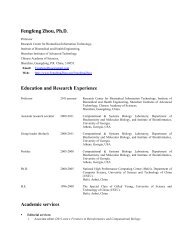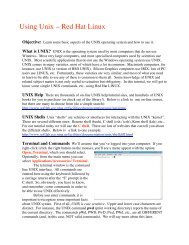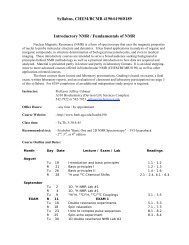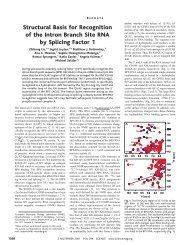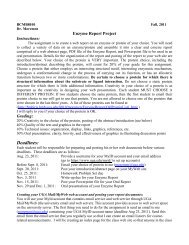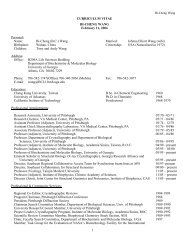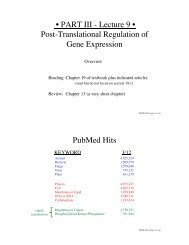Amyloid arthropathy in chickens - Biochemistry and Molecular Biology
Amyloid arthropathy in chickens - Biochemistry and Molecular Biology
Amyloid arthropathy in chickens - Biochemistry and Molecular Biology
You also want an ePaper? Increase the reach of your titles
YUMPU automatically turns print PDFs into web optimized ePapers that Google loves.
This article was downloaded by: [University of Georgia]<br />
On: 19 October 2012, At: 10:38<br />
Publisher: Taylor & Francis<br />
Informa Ltd Registered <strong>in</strong> Engl<strong>and</strong> <strong>and</strong> Wales Registered Number: 1072954 Registered office: Mortimer<br />
House, 37-41 Mortimer Street, London W1T 3JH, UK<br />
Veter<strong>in</strong>ary Quarterly<br />
Publication details, <strong>in</strong>clud<strong>in</strong>g <strong>in</strong>structions for authors <strong>and</strong> subscription <strong>in</strong>formation:<br />
http://www.t<strong>and</strong>fonl<strong>in</strong>e.com/loi/tveq20<br />
<strong>Amyloid</strong> <strong>arthropathy</strong> <strong>in</strong> <strong>chickens</strong><br />
W.J.M. L<strong>and</strong>man a<br />
a Animal Health Service, Poultry Health Centre, Arnsbergstraat 7, Deventer, 7418 EZ,<br />
the Netherl<strong>and</strong>s<br />
Version of record first published: 01 Nov 2011.<br />
To cite this article: W.J.M. L<strong>and</strong>man (1999): <strong>Amyloid</strong> <strong>arthropathy</strong> <strong>in</strong> <strong>chickens</strong>, Veter<strong>in</strong>ary Quarterly, 21:3, 78-82<br />
To l<strong>in</strong>k to this article: http://dx.doi.org/10.1080/01652176.1999.9694998<br />
PLEASE SCROLL DOWN FOR ARTICLE<br />
Full terms <strong>and</strong> conditions of use: http://www.t<strong>and</strong>fonl<strong>in</strong>e.com/page/terms-<strong>and</strong>-conditions<br />
This article may be used for research, teach<strong>in</strong>g, <strong>and</strong> private study purposes. Any substantial or systematic<br />
reproduction, redistribution, resell<strong>in</strong>g, loan, sub-licens<strong>in</strong>g, systematic supply, or distribution <strong>in</strong> any form to<br />
anyone is expressly forbidden.<br />
The publisher does not give any warranty express or implied or make any representation that the contents<br />
will be complete or accurate or up to date. The accuracy of any <strong>in</strong>structions, formulae, <strong>and</strong> drug doses<br />
should be <strong>in</strong>dependently verified with primary sources. The publisher shall not be liable for any loss,<br />
actions, claims, proceed<strong>in</strong>gs, dem<strong>and</strong>, or costs or damages whatsoever or howsoever caused aris<strong>in</strong>g<br />
directly or <strong>in</strong>directly <strong>in</strong> connection with or aris<strong>in</strong>g out of the use of this material.
a<br />
)1 f---111 1I F-11% / I / mom Ma Mull<br />
WIN IN I<br />
MI MN tom sit<br />
AMYLOID ARTHROPATHY IN CHICKENS<br />
(SUMMARY OF THESIS, UTRECHT UNIVERSITY, FACULTY OF VETERINARY MEDICINE, 1998)<br />
W.J.M. L<strong>and</strong>man1<br />
Vet Quart 1999; 21: 78-82<br />
Accepted for publication: January 20, 1999.<br />
Downloaded by [University of Georgia] at 10:38 19 October 2012<br />
SUMMARY<br />
The present paper presents an overview of current knowledge<br />
of amyloid <strong>arthropathy</strong> <strong>in</strong> <strong>chickens</strong>, <strong>and</strong> covers the<br />
pathogenesis of amyloidosis <strong>in</strong> general <strong>and</strong> <strong>in</strong> birds, field<br />
cases reported, <strong>and</strong> the studies performed to assess the<br />
amyloidogenicity of various agents compared to that of<br />
Enterococcus faecalis. An animal model of amyloid<br />
<strong>arthropathy</strong> is presented, as are studies on the pathogenesis<br />
of arthropathic <strong>and</strong> amyloidogenic E. faecalis <strong>in</strong>fections<br />
<strong>in</strong> brown layers. The review concludes with a description<br />
of the pathology of amyloid <strong>arthropathy</strong>, the<br />
biochemical characterization of the chicken jo<strong>in</strong>t amyloid<br />
prote<strong>in</strong> as be<strong>in</strong>g of the AA type, <strong>in</strong>vestigation of the<br />
serum amyloid A (SAA) gene <strong>in</strong>volved, <strong>and</strong> local SAA<br />
mRNA expression <strong>in</strong> jo<strong>in</strong>t <strong>and</strong> liver.<br />
INTRODUCTION<br />
<strong>Amyloid</strong>osis is a well-recognized pathological disorder<br />
especially <strong>in</strong> waterfowl, <strong>and</strong> although extensive studies have<br />
been performed on its pathomorphology <strong>and</strong> epidemiology,<br />
knowledge of the pathogenesis of avian amyloidosis, <strong>and</strong><br />
amyloidosis <strong>in</strong> general, is still <strong>in</strong>complete.<br />
The highest <strong>in</strong>cidence <strong>in</strong> captive wild birds is seen <strong>in</strong><br />
Anseriformes, Gruiformes, <strong>and</strong> Phoenicopteriformes (67).<br />
With<strong>in</strong> the Anseriformes, the Anatidae are especially prone<br />
to develop amyloidosis (47, 8, 19, 48). As <strong>in</strong> wild Anat<strong>in</strong>ae,<br />
<strong>in</strong> domestic ducks systemic amyloid A (AA) prote<strong>in</strong> amyloidosis<br />
is a common pathological disorder (43, 44, 45, 46, 14,<br />
31, 32, 16) that has been found to be associated with chronic<br />
<strong>in</strong>flammatory disease (13). Differences between species<br />
have been reported <strong>in</strong> both caged wild fowl (9, 67) <strong>and</strong> domestic<br />
ducks (33). There were few reports describ<strong>in</strong>g the occurrence<br />
of systemic amyloidosis <strong>in</strong> <strong>chickens</strong> (64, 61, 52)<br />
before our description of amyloid <strong>arthropathy</strong> <strong>in</strong> <strong>chickens</strong><br />
(24). The articular localization seems characteristic for<br />
Galliformes (34, 51, 28). <strong>Amyloid</strong>osis is becom<strong>in</strong>g.a cl<strong>in</strong>ical<br />
problem of <strong>in</strong>creas<strong>in</strong>g importance <strong>in</strong> several European countries<br />
(3, 29), with up to 20-30% of commercial flocks be<strong>in</strong>g<br />
affected. In most cases brown layers are <strong>in</strong>volved.<br />
This article summarizes our knowledge of (avian) amyloidosis,<br />
the occurrence, the nature, the pathogenesis, <strong>and</strong> possible<br />
aetiological factors of amyloid <strong>arthropathy</strong> <strong>in</strong> <strong>chickens</strong>, <strong>and</strong><br />
the identification <strong>and</strong> characterization of the amyloid prote<strong>in</strong><br />
<strong>and</strong> the gene. Studies were conducted at the Poultry Health<br />
Centre of the Animal Health Service <strong>in</strong> Deventer <strong>and</strong> the<br />
Department of Veter<strong>in</strong>ary Pathology of the Utrecht<br />
University, the Netherl<strong>and</strong>s (27).<br />
(AVIAN) AMYLOIDOSIS IN GENERAL<br />
<strong>Amyloid</strong>osis has been def<strong>in</strong>ed as the extracellular deposition<br />
of normally autologous soluble prote<strong>in</strong>s or fragments thereof<br />
Animal Health Service, Poultry Health Centre, Arnsbergstraat 7, 7418 EZ Deventer,<br />
the Netherl<strong>and</strong>s.<br />
(the precursor prote<strong>in</strong>s) <strong>in</strong> various tissues <strong>and</strong> organs <strong>in</strong> a<br />
characteristic fibrillar form. Although amyloid deposits have<br />
been described for more than a century <strong>and</strong> a half, their fibrillar<br />
nature was not revealed until after 1950. The molecular<br />
structure of amyloid (13-pleated sheet) was identified much<br />
later by us<strong>in</strong>g X-ray <strong>and</strong> <strong>in</strong>fra-red spectroscopy (11). Both<br />
the primary am<strong>in</strong>o acid sequence <strong>and</strong> the secondary molecular<br />
structure (13-sheets) of amyloid prote<strong>in</strong>s are thought to be<br />
responsible for their congophilia <strong>and</strong> low solubility (7, 23).<br />
The low solubility <strong>and</strong> the relative resistance to proteolytic<br />
digestion of amyloid fibrils under physiological conditions<br />
are thought to be the cause of the irreversible course of amyloidosis.<br />
The disease is often fatal <strong>in</strong> mammals with<strong>in</strong><br />
months or a few years after diagnosis (17).<br />
The biochemical characterization of amyloids has shown<br />
that several non-related prote<strong>in</strong>s can re-organize <strong>in</strong>to amyloid<br />
fibrils. At present, more than 17 amyloid prote<strong>in</strong>s of human<br />
<strong>and</strong> animal orig<strong>in</strong> have been characterized which differ<br />
<strong>in</strong> their primary am<strong>in</strong>o acid sequence. While <strong>in</strong> humans localized<br />
cerebral amyloid associated with senescence <strong>and</strong> mental<br />
retardation is most prevalent, <strong>in</strong> animals most amyloid deposits<br />
are of the reactive or AA type, made of the acute phase<br />
(precursor) prote<strong>in</strong> serum amyloid A (SAA). To date, <strong>in</strong><br />
caged wild <strong>and</strong> domestic birds only systemic AA amyloidosis<br />
has been described, although theoretically other not yet<br />
recognized forms might exist.<br />
It is noteworthy that the pathogenesis of this <strong>in</strong>terest<strong>in</strong>g but<br />
complex disorder is still not well understood, especially at<br />
the molecular level. Multiple factors act<strong>in</strong>g <strong>in</strong> concert are<br />
thought to play a role <strong>in</strong> amyloid fibril formation. Because it<br />
is a two-phase process (62, 53), an <strong>in</strong>creased pool of precursor<br />
prote<strong>in</strong> SAA is required before AA amyloid fibril formation<br />
or AA activation occurs. The up-regulation of SAA genes<br />
is <strong>in</strong> fact a normal physiological response to <strong>in</strong>flammatory<br />
stimuli <strong>and</strong> provides the required pool of SAA for<br />
amyloidogenesis, but will only lead to amyloid formation <strong>in</strong><br />
a small subset of <strong>in</strong>dividuals with a prolonged acute phase<br />
response. Therefore, additional factors must be necessary for<br />
AA amyloidogenesis.<br />
In some cases certa<strong>in</strong> am<strong>in</strong>o acid substitutions of the precursor<br />
prote<strong>in</strong> may favour the, amyloidogenicity of the isotypes<br />
(50, 5, 54, 63), facilitat<strong>in</strong>g the occurrence of unstable <strong>in</strong>termediate<br />
prote<strong>in</strong> conformations that easily adapt <strong>in</strong>to 13-<br />
pleated sheets (4) or, as more recently proposed, <strong>in</strong>to 13-<br />
helixes (30). Alternatively, some substitutions may confer<br />
resistance to fibrillogenesis (6). Although an amyloidogenic<br />
am<strong>in</strong>o acid sequence is necessary for a precursor prote<strong>in</strong> to<br />
cause amyloid formation, it is not the sole determ<strong>in</strong>ant because<br />
amyloid formation does not occur <strong>in</strong> all patients with<br />
such sequences. Thus, the action of other factors seems<br />
necessary to <strong>in</strong>itiate fibrillogenesis, e.g. the presence of<br />
amyloid-enhanc<strong>in</strong>g factor, which may act as a nidus for 13-<br />
pleated nucleation (38). Also, the presence of certa<strong>in</strong> <strong>in</strong>organic<br />
ions such as calcium (35, 1), proteoglycans, <strong>and</strong> their<br />
-<br />
.<br />
78<br />
THE VETERINARY QUARTERLY, VOL 2 1 , No 3 , J U N E , 1 9 9 9
Nem t-\ gn Novi r97., Ira mk IP% Wu 00%<br />
u Milli II 116. <strong>in</strong> ries lir Iry %IP<br />
Downloaded by [University of Georgia] at 10:38 19 October 2012<br />
glycosam<strong>in</strong>oglycans (55, 56, 57, 58), pentrax<strong>in</strong>es such as<br />
serum amyloid P (SAP) (41), apolipoprote<strong>in</strong> E (42, 22), <strong>and</strong><br />
an altered metabolism of basement membrane prote<strong>in</strong>s (2)<br />
are thought to contribute to amyloidogenesis. They act as<br />
stabilizers <strong>in</strong>ducers or <strong>in</strong>ductors of13-pleated sheet formation<br />
(35), facilitat<strong>in</strong>g amyloid deposition <strong>and</strong> <strong>in</strong>hibit<strong>in</strong>g clearance<br />
mechanisms (58, 63). Proteolysis, represents a step <strong>in</strong> the<br />
maturation of amyloid deposits rather than <strong>in</strong> their formation,<br />
because the precursor prote<strong>in</strong> SAA is deposited <strong>in</strong> its<br />
<strong>in</strong>tact form <strong>in</strong> amyloid deposits of duck (12), cow (39),<br />
mouse, <strong>and</strong> other species (59, 60, 66). In <strong>chickens</strong>, <strong>in</strong>dications<br />
for SAA fibril deposition have been found <strong>in</strong> amyloid<br />
precipitates (25).<br />
AMYLOID ARTHROPATHY AND POSSIBLE AETIO-<br />
LOGY<br />
The first description of amyloid <strong>arthropathy</strong> <strong>in</strong> <strong>chickens</strong> <strong>in</strong>dicated<br />
that affected birds show a characteristic stiff gait <strong>and</strong><br />
marked growth retardation (24). The condition occurred<br />
ma<strong>in</strong>ly dur<strong>in</strong>g the rear<strong>in</strong>g period, with cl<strong>in</strong>ical signs be<strong>in</strong>g<br />
observed from 5 to 6 weeks of age onwards. The morbidity <strong>in</strong><br />
most flocks was 1 to 4%, but <strong>in</strong> some cases it was as high as<br />
20%. In 35% of necropsied birds articular amyloid deposits<br />
were found <strong>and</strong> classified as be<strong>in</strong>g of the AA type because of<br />
the positive reaction with anti-duck <strong>and</strong> anti-bov<strong>in</strong>e AA antisera<br />
on peroxidase-antiperoxidase (PAP) sta<strong>in</strong><strong>in</strong>g. An association<br />
with Enterococcus faecalis was proposed because<br />
this bacterium was isolated <strong>in</strong> 2 out of 6 flocks (from jo<strong>in</strong>ts of<br />
10% of affected birds). Reovirus was isolated <strong>in</strong> 1 out of 6<br />
flocks.<br />
Review of additional field cases <strong>and</strong> rout<strong>in</strong>e post-mortem<br />
exam<strong>in</strong>ation of samples sent to the Poultry Health Centre of<br />
the Animal Health Service <strong>in</strong> Deventer <strong>in</strong> 1996-1997 revealed<br />
that amyloid <strong>arthropathy</strong> occurred <strong>in</strong> 12.9% of necropsied<br />
brown layers, but <strong>in</strong> only 2.9% of broiler breeders<br />
(29). The condition was never encountered <strong>in</strong> white layers<br />
<strong>and</strong> broiler <strong>chickens</strong>. The absence of amyloid <strong>arthropathy</strong> <strong>in</strong><br />
the latter group was not unexpected as these birds have a life<br />
span of approximately 7 weeks maximally. In brown layers,<br />
E. faecalis was the major pathogen isolated (46/60) from<br />
amyloidotic jo<strong>in</strong>ts positive on bacteriology (60/303), while<br />
Staphylococcus aureus (47/64) was ma<strong>in</strong>ly isolated from the<br />
amyloidotic jo<strong>in</strong>ts of broiler breeders (64/86). When<br />
necropsy data were analysed per year, the prevalence of<br />
amyloid <strong>arthropathy</strong> was found to have <strong>in</strong>creased <strong>in</strong> both<br />
brown layers <strong>and</strong> broiler parent birds. Of necropsied brown<br />
layers, 11% (118/1070) suffered from amyloid <strong>arthropathy</strong><br />
<strong>in</strong> 1996 <strong>and</strong> 15.2% (131/860) <strong>in</strong> 1997. For broiler parent<br />
birds the proportions were 0.9% (11/1190) <strong>and</strong> 6.5%<br />
(42/625), respectively. Affected flocks were housed <strong>in</strong> cages<br />
as well as on litter, <strong>and</strong> no season variability was observed <strong>in</strong><br />
the occurrence of amyloid <strong>arthropathy</strong>.<br />
While <strong>in</strong>vestigat<strong>in</strong>g the role of various agents <strong>in</strong> chicken<br />
amyloid <strong>arthropathy</strong> (29), it was shown that primarily E.<br />
faecalis <strong>and</strong> Freund's adjuvans were able to elicit extensive<br />
amyloid <strong>arthropathy</strong> <strong>in</strong> brown layer pullets, with there be<strong>in</strong>g<br />
marked differences between E. faecalis isolates. Of the other<br />
micro-organisms studied, S. aureus, Salmonella enteritidis,<br />
<strong>and</strong> Escherichia coli were also able to cause jo<strong>in</strong>t amyloidosis;<br />
however, the amount of amyloid deposited was<br />
very small <strong>and</strong> cl<strong>in</strong>ical symptoms were m<strong>in</strong>imal.<br />
Mycoplasma synoviae, <strong>in</strong>activated E. faecalis, chicken<br />
anaemia virus, <strong>and</strong> reovirus did not cause amyloid <strong>arthropathy</strong><br />
after <strong>in</strong>tra-articular <strong>in</strong>oculation. These results are <strong>in</strong> l<strong>in</strong>e<br />
with data from an <strong>in</strong>ventory of additional field cases where<br />
E. faecalis was isolated from jo<strong>in</strong>ts <strong>in</strong> 12% of affected<br />
brown layers, which suggests that this bacterium has a role<br />
<strong>in</strong> the pathogenesis of jo<strong>in</strong>t amyloidosis <strong>in</strong> <strong>chickens</strong>. The<br />
importance of E. faecalis as an aetiological agent for amyloid<br />
<strong>arthropathy</strong> <strong>in</strong> the field may have been overlooked because<br />
the bacteria may be conf<strong>in</strong>ed to articular pouches <strong>in</strong><br />
chronic arthritis which makes their isolation difficult. This<br />
could lead to a number of false negative results. Studies<br />
compar<strong>in</strong>g sampl<strong>in</strong>g techniques as well as growth media<br />
need to be performed to address this issue.<br />
Indications for clonal spread of amyloidogenic <strong>and</strong> amyloidassociated<br />
E. faecalis isolates were found after stra<strong>in</strong> typ<strong>in</strong>g<br />
by restriction endonuclease fragment analysis of chromosomal<br />
DNA by pulsed-field gel electrophoresis (PFGE) after<br />
Sma I digestion (29). The observation of identical restriction<br />
endonuclease digestion (RED) patterns <strong>in</strong> E. faecalis isolates<br />
collected from field cases over a 4-year period <strong>and</strong> from<br />
several European countries <strong>in</strong>dicates that they can be stable<br />
<strong>in</strong> nature over a number of years. This is <strong>in</strong> agreement with<br />
the results of other studies where E. faecalis stra<strong>in</strong>s were<br />
found to have stable RED patterns over even longer periods<br />
of 7 (49) <strong>and</strong> 8 years (37). The persistence <strong>and</strong> spread of a<br />
s<strong>in</strong>gle arthropathic <strong>and</strong> amyloidogenic clone for at least 4<br />
years justifies further <strong>in</strong>vestigation of its epidemiology <strong>and</strong><br />
pathogenicity. This will help <strong>in</strong>vestigators to develop <strong>and</strong><br />
promote measures that will reduce the transmission of these<br />
stra<strong>in</strong>s.<br />
INDUCTION OF AMYLOID ARTHROPATHY WITH<br />
ENTEROCOCCUS FAECALIS AND TRANSMISSION<br />
STUDIES<br />
AA jo<strong>in</strong>t amyloidosis <strong>in</strong> <strong>chickens</strong> can be <strong>in</strong>duced by a s<strong>in</strong>gle<br />
<strong>in</strong>jection of E. faecalis isolated from field outbreaks of reactive<br />
amyloid <strong>arthropathy</strong> <strong>in</strong> brown layers (26). All 6-weekold<br />
brown layer pullets <strong>in</strong>jected <strong>in</strong>travenously with 108 or<br />
109 colony-form<strong>in</strong>g units (cfu) developed reactive amyloid<br />
<strong>arthropathy</strong>. <strong>Amyloid</strong> masses were . also present <strong>in</strong> the <strong>in</strong>ternal<br />
organs. The first articular amyloid deposits were observed<br />
5 days after <strong>in</strong>jection whereas such depositswere encountered<br />
<strong>in</strong> the <strong>in</strong>ternal organs from day 13 onwards. On<br />
<strong>in</strong>tra-articular <strong>in</strong>jection, amyloidosis developed particularly<br />
<strong>in</strong> the target jo<strong>in</strong>t <strong>and</strong> <strong>in</strong> the <strong>in</strong>ternal organs, suggest<strong>in</strong>g local<br />
SAA production <strong>and</strong> fibrillogenesis. The results obta<strong>in</strong>ed<br />
with this novel animal model for amyloid <strong>arthropathy</strong> are<br />
consistent with those of other major animal models for AA<br />
(15) <strong>and</strong> fit with the current hypothesis for the role of acutephase<br />
prote<strong>in</strong> serum amyloid A <strong>in</strong> the pathogenesis of AA<br />
(18, 60).<br />
The pathogenesis of arthropathic <strong>and</strong> amyloidogenic E. faecalls<br />
<strong>in</strong>fections <strong>in</strong> brown layers was studied us<strong>in</strong>g our animal<br />
model as a positive control. <strong>Amyloid</strong> <strong>arthropathy</strong> was elicited<br />
<strong>in</strong> 6-week-old pullets after <strong>in</strong>travenous, <strong>in</strong>tra-articular,<br />
<strong>and</strong> <strong>in</strong>traperitoneal <strong>in</strong>oculation of high doses (109 cfu), but it<br />
was not after <strong>in</strong>tramuscular, oral, <strong>and</strong> <strong>in</strong>tratracheal <strong>in</strong>oculation.<br />
Similarly, oral <strong>in</strong>oculation of 1-day-old chicks with 108<br />
cfu did not cause any pathology; however, <strong>in</strong>tramuscular <strong>in</strong>oculation<br />
with 106 cfu resulted <strong>in</strong> severe growth retardation<br />
<strong>and</strong> arthritis <strong>in</strong> 60% of the birds, <strong>and</strong> jo<strong>in</strong>t amyloidosis <strong>in</strong> approximately<br />
40%, reflect<strong>in</strong>g the existence ofage resistance<br />
for this route. Transmission of arthropathic <strong>and</strong> amyloidogenic<br />
E. faecalis to 1-day-old chicks might occur as a result<br />
of <strong>in</strong>tramuscular vacc<strong>in</strong>ation with Marek's disease vacc<strong>in</strong>e<br />
because samples of hatchery air (hatcher <strong>and</strong> process<strong>in</strong>g<br />
79<br />
THE VETERINARY QUARTERLY, VOL 2 1 , N o 3 , JUNE, 1999
RnIPNIBR 17<br />
u -u 11/<br />
a worm<br />
Downloaded by [University of Georgia] at 10:38 19 October 2012<br />
room), Marek's disease vacc<strong>in</strong>e suspensions, <strong>and</strong> <strong>in</strong>jection<br />
needles were found to be contam<strong>in</strong>ated with vary<strong>in</strong>g <strong>and</strong><br />
sometimes high levels (< 10 to 106 cfu/ml vacc<strong>in</strong>e suspension<br />
<strong>and</strong> approximately 104 cfu/<strong>in</strong>jection needle) of E. faecalis.<br />
If vacc<strong>in</strong>e suspensions <strong>and</strong> <strong>in</strong>jection needles were contam<strong>in</strong>ated<br />
with arthropathic <strong>and</strong> amyloidogenic stra<strong>in</strong>s, then<br />
amyloid <strong>arthropathy</strong> could have been <strong>in</strong>duced <strong>in</strong> those birds<br />
<strong>in</strong>jected with = 106 cfu. Arthritis had already developed <strong>in</strong><br />
some birds <strong>in</strong>jected with lower doses (165 cfu). PFGE of<br />
hatchery stra<strong>in</strong>s showed that dom<strong>in</strong>ant RED patterns can occur<br />
<strong>in</strong> a particular hatchery. One of the isolates showed a<br />
b<strong>and</strong><strong>in</strong>g pattern (1 fragment difference) that was similar to<br />
that of a known arthropathic <strong>and</strong> amyloidogenic isolate.<br />
In egg transmission studies neither egg dipp<strong>in</strong>g nor <strong>in</strong>oculation<br />
of the air chamber with E. faecalis reproduced the condition,<br />
although E. faecalis caused septicaemia <strong>in</strong> a few chicks.<br />
Yolk sac <strong>in</strong>oculation of embryonated eggs <strong>in</strong>cubated for 6<br />
days caused embryonic death with<strong>in</strong> a few days, which suggests<br />
that transovaric transmission is unlikely. In contrast, <strong>in</strong>oculation<br />
of egg albumen with lower doses of the isolate led<br />
to later embryo mortality, some hatch<strong>in</strong>g chicks, <strong>and</strong> E. faecalls<br />
arthritis transmission to 1 out of 6 hatched chicks, which<br />
<strong>in</strong>dicates the possibility of transoviductal transmission.<br />
Indications for vertical transmission of arthropathic <strong>and</strong><br />
amyloidogenic E. faecalis on a small scale were found after<br />
brown layer parent birds were <strong>in</strong>travenously <strong>in</strong>oculated with<br />
high doses (109 cfu) of E. faecalis. The <strong>in</strong>oculated birds<br />
developed chronic bacteraemia <strong>and</strong> arthritis, <strong>and</strong> <strong>in</strong> several<br />
cases amyloid <strong>arthropathy</strong> (2/6): egg production was decreased.<br />
E. faecalis was isolated from the ovaries <strong>and</strong><br />
oviducts of all birds that died due to septicaemia, <strong>and</strong> from<br />
the egg content of 76% (13/17) of c<strong>and</strong>led <strong>and</strong> 100% (6/6) of<br />
non-hatch<strong>in</strong>g eggs of the first 2 (out of 6) production weeks<br />
after <strong>in</strong>oculation. It was also cultured from arthritic jo<strong>in</strong>ts of<br />
3% (2/66) of the hatched chicks of the same batch at 8 weeks<br />
of age. However, the chicks did not develop jo<strong>in</strong>t amyloidosis.<br />
The mortality pattern of embryos (E. faecalis- positive<br />
deaths <strong>in</strong> shell) is <strong>in</strong> l<strong>in</strong>e with that found after egg albumen<br />
<strong>in</strong>oculation of embryonated eggs with lower doses, suggest<strong>in</strong>g<br />
aga<strong>in</strong> that transoviductal transmission occurs. Although<br />
ovaric transmission may occur, it will probably result <strong>in</strong> an<br />
early embryo mortality similar to that of high-dose contam<strong>in</strong>ation<br />
of egg albumen.<br />
Dur<strong>in</strong>g these studies natural <strong>in</strong>fection routes were not found.<br />
However, <strong>in</strong>tramuscular vacc<strong>in</strong>ation aga<strong>in</strong>st Marek's disease<br />
of 1-day-old chicks might result <strong>in</strong> amyloid <strong>arthropathy</strong><br />
depend<strong>in</strong>g on the presence of AA <strong>in</strong>duc<strong>in</strong>g pathotypes. This<br />
could be favoured by vertical transmission of the pathogenic<br />
bacterium, as suggested by the experimental data <strong>and</strong> field<br />
f<strong>in</strong>d<strong>in</strong>gs. Infected eggs <strong>and</strong> chicks represent a source of<br />
arthropathic <strong>and</strong> amyloidogenic E. faecalis that could contam<strong>in</strong>ate<br />
hatchery air <strong>and</strong> Marek's disease vacc<strong>in</strong>e suspensions<br />
after colonization <strong>and</strong> replication of the bacterium <strong>in</strong><br />
the <strong>in</strong>test<strong>in</strong>es of newborns (20, 21, 10). Chicks <strong>in</strong>oculated<br />
with sufficiently high doses would develop the condition <strong>and</strong><br />
show the typical cl<strong>in</strong>ical <strong>and</strong> pathological lesions.<br />
This scenario is <strong>in</strong> l<strong>in</strong>e with the cl<strong>in</strong>ical problems of amyloid<br />
<strong>arthropathy</strong> described <strong>in</strong> the field. These problems are encountered<br />
mostly dur<strong>in</strong>g the early rear<strong>in</strong>g period <strong>and</strong> are said<br />
to resolve once affected birds are culled, <strong>in</strong>dicat<strong>in</strong>g that<br />
transmission by natural routes is <strong>in</strong>efficient. In some field<br />
cases, however, cl<strong>in</strong>ical amyloid <strong>arthropathy</strong> developed dur<strong>in</strong>g<br />
the production period <strong>in</strong> well-developed hens, which<br />
suggests the existence of additional <strong>in</strong>fection routes that may<br />
enable <strong>in</strong>test<strong>in</strong>al E. faecalis <strong>in</strong> sufficient numbers to ga<strong>in</strong> access<br />
to the blood stream before the jo<strong>in</strong>t is colonized.<br />
PATHOLOGY OF AMYLOID ARTHROPATHY IN<br />
CHICKENS<br />
The light microscopic, immunohistochemical, <strong>and</strong> electron<br />
microscopic features of amyloid <strong>arthropathy</strong> <strong>in</strong> <strong>chickens</strong><br />
have been documented (40). Predom<strong>in</strong>antly, femoro-tibial<br />
<strong>and</strong> tarso-metatarsal jo<strong>in</strong>ts are affected, show<strong>in</strong>g (peri)articular<br />
orange amyloid deposits. Immunohischemical evaluation<br />
reveals the amyloid to be of the reactive type. In the<br />
naturally occurr<strong>in</strong>g disease <strong>and</strong> <strong>in</strong> <strong>in</strong>duced disease, amyloid<br />
deposits are found <strong>in</strong> the hypertrophic synovial villi <strong>and</strong> <strong>in</strong><br />
the articular cartilage, particularly <strong>in</strong> the superficial layer<br />
<strong>and</strong> <strong>in</strong> the nutritional blood vessel walls. Highly sulphated<br />
glycosam<strong>in</strong>oglycans (GAGs), which supposedly play an important<br />
role <strong>in</strong> amyloid fibrillogenesis because they stabilize<br />
or <strong>in</strong>duce B-sheet<strong>in</strong>g of SAA (55, 56, 35), are also found to<br />
co-localize with chicken jo<strong>in</strong>t amyloid. Ultrastructurally,<br />
bundles of amyloid fibrils are seen <strong>in</strong> <strong>in</strong>vag<strong>in</strong>ations ofsynoviocytes<br />
<strong>and</strong> chondrocytes. Immunogold electron microscopy,<br />
however, has failed to reveal signs of <strong>in</strong>tracellular<br />
amyloid formation.<br />
CHARACTERIZATION OF CHICKEN AA, SAA, AND<br />
THE GENE INVOLVED<br />
The amyloid fibrils extracted from deposits <strong>in</strong> jo<strong>in</strong>t tissue of<br />
brown layers with spontaneous amyloid <strong>arthropathy</strong> were<br />
characterized by am<strong>in</strong>o acid sequenc<strong>in</strong>g as be<strong>in</strong>g of the AA<br />
type (25). The am<strong>in</strong>o acid pattern found was quite similar to<br />
that of duck AA. Acute-phase sera of chicken experimentally<br />
<strong>in</strong>jected with E. faecalis showed a SAA prote<strong>in</strong>-like<br />
b<strong>and</strong> that cross-reacted with polyclonal anti-chicken AA on<br />
immunoblott<strong>in</strong>g. This b<strong>and</strong> occurred approximately at the<br />
same level as the major b<strong>and</strong> ( 14 kDa) of the major retarded<br />
peak of distilled water-extracted <strong>and</strong> guanid<strong>in</strong>e-HC1 dissolved<br />
amyloid fibrils after Sephacryl S-200 chromatography,<br />
while a second smaller peak ( 9 kDa) appeared to<br />
be AA, as evidenced by am<strong>in</strong>o acid sequenc<strong>in</strong>g. This f<strong>in</strong>d<strong>in</strong>g<br />
<strong>in</strong>dicates that SAA deposition occurs <strong>in</strong> chicken jo<strong>in</strong>t amyloid<br />
as has been described <strong>in</strong> other species (12, 39, 66),<br />
where SAA is transformed <strong>in</strong>to amyloid fibrils prior to C-term<strong>in</strong>al<br />
proteolytic cleavage <strong>and</strong> transformation <strong>in</strong>to mature<br />
AA fibrils.<br />
Post-mortem data from commercial <strong>chickens</strong> collected over<br />
a 2-year period showed that amyloid <strong>arthropathy</strong> occurred<br />
regularly <strong>in</strong> brown layers, whereas the white layerswere free<br />
of this disease. The susceptibility of brown layers was confirmed<br />
experimentally by <strong>in</strong>jection of arthropathic <strong>and</strong> amyloidogenic<br />
E. faecalis from a spontaneous case. As both<br />
breeds, brown <strong>and</strong> white layers, are bred <strong>and</strong> kept under similar<br />
management conditions, a genetic basis for this difference<br />
is likely. The enhanced susceptibility of organisms to<br />
develop systemic AA type amyloidosis has often been attributed<br />
to the expression of an amyloidogenic SAA prote<strong>in</strong>.<br />
Characterization of the chicken SAA gene has revealed that<br />
it is a s<strong>in</strong>gle copy gene conta<strong>in</strong><strong>in</strong>g 4 exons,.of which the first<br />
is not expressed. Unexpectedly, SAA cDNA sequences of<br />
brown <strong>and</strong> white layers <strong>in</strong>dicate that the primary translation<br />
products are identical <strong>in</strong> the two breeds. Thus the difference<br />
<strong>in</strong> susceptibility between these two breeds might be caused<br />
by differential expression of the SAA gene, or by factors<br />
which <strong>in</strong>fluence amyloid prote<strong>in</strong> deposition.<br />
F<strong>in</strong>ally, <strong>in</strong> situ hybridization studies have revealed SAA<br />
80<br />
THE VETERINARY QUARTERLY, VOL 21, No 3, JUNE, 1999
7-) Ira /11 gm TVA t r oft aft<br />
crliVJ,<br />
Downloaded by [University of Georgia] at 10:38 19 October 2012<br />
mRNA expression <strong>in</strong> both, the liver <strong>and</strong> the altered synovial<br />
membrane of amyloidotic birds, which suggests that the synovial<br />
production of SAA is important <strong>in</strong> the development of<br />
Jo<strong>in</strong>t amyloidosis. The synthesis of SAA by the synovial fibroblasts<br />
of rabbits has been reported (36), but not <strong>in</strong> relation<br />
to local amyloid deposition, which makes this f<strong>in</strong>d<strong>in</strong>g of particular<br />
<strong>in</strong>terest.<br />
CONCLUDING OVERVIEW<br />
<strong>Amyloid</strong> <strong>arthropathy</strong> <strong>in</strong> <strong>chickens</strong> is, <strong>in</strong> a number of cases, a<br />
complication of bacteraemia derived chronic (poly)arthritis,<br />
where E. faecalis is considered to be a causative agent, especially<br />
<strong>in</strong> brown layers. Its primary aetiological importance <strong>in</strong><br />
the field might have been overlooked due to the chronic nature<br />
of the disorder <strong>and</strong> because of shortcom<strong>in</strong>gs <strong>in</strong> the isolation<br />
systems used. The persistent acute-phase response <strong>in</strong>duced<br />
by E. faecalis will provide an adequate pool of the<br />
precursor prote<strong>in</strong> SAA necessary for SAA <strong>and</strong> AA fibril formation.<br />
The specific articular localization of amyloid deposits<br />
<strong>in</strong> Galliformes may be expla<strong>in</strong>ed by <strong>in</strong> situ SAA mRNA<br />
production, as shown by hybridization <strong>in</strong> brown layers.<br />
Haematogenous spread of E. faecalis is necessary to penetrate<br />
<strong>and</strong> <strong>in</strong>fect the jo<strong>in</strong>ts. In this respect, the <strong>in</strong>tramuscular<br />
Marek's disease vacc<strong>in</strong>ation of day-old chicks at the<br />
hatchery may represent a possible <strong>in</strong>fection route, lead<strong>in</strong>g to<br />
. cl<strong>in</strong>ical problems dur<strong>in</strong>g the rear<strong>in</strong>g period. Small-scale<br />
transoviductal transmission could represent a pathway for<br />
arthropathic <strong>and</strong> amyloidogenic E. faecalis contam<strong>in</strong>ation of<br />
chicks. After horizontal spread <strong>and</strong> multiplication <strong>in</strong> flockmates,<br />
hatchery air, Marek's disease vacc<strong>in</strong>e suspensions,<br />
<strong>and</strong> <strong>in</strong>jection needles could become contam<strong>in</strong>ated. However,<br />
a role for faecal-egg shell contam<strong>in</strong>ation <strong>in</strong> transmission to<br />
chicks cannot be excluded, because small-scale transmission<br />
ofE. faecalis to offspr<strong>in</strong>g was achieved after egg dipp<strong>in</strong>g <strong>and</strong><br />
air chamber <strong>in</strong>oculation.<br />
Although natural <strong>in</strong>fection routes have not been found, their<br />
existence is speculated upon because amyloid <strong>arthropathy</strong> is<br />
sometimes recorded <strong>in</strong> older well-developed birds after diseased<br />
birds <strong>in</strong> affected flocks have been culled. Also, the presence<br />
of antibodies to E. faecalis <strong>in</strong> <strong>in</strong>tratracheally <strong>and</strong> orally <strong>in</strong>fected<br />
birds suggests their existence. Investigations to evaluate<br />
the effect of a number of factors on E. faecalis translocation,<br />
dual <strong>in</strong>fections with other pathogens that affect the <strong>in</strong>tegrity of<br />
the <strong>in</strong>test<strong>in</strong>es, comb<strong>in</strong>ed <strong>in</strong>fections with immunosuppressive<br />
agents, aerosol transmission, etcetera, may contribute to our<br />
underst<strong>and</strong><strong>in</strong>g of the pathogenesis of <strong>in</strong>vasive E. faecalis <strong>in</strong>fections<br />
<strong>and</strong> related amyloid <strong>arthropathy</strong> <strong>in</strong> <strong>chickens</strong>.<br />
The clonal spread of arthropathic <strong>and</strong> amyloidogenic E. faecalls<br />
justifies further research on the epidemiology <strong>and</strong><br />
pathogenesis of this micro-organism. On the basis of the <strong>in</strong>formation<br />
obta<strong>in</strong>ed, programmes for the screen<strong>in</strong>g of flocks<br />
for the occurrence of pathogenic E. faecalis can be set up <strong>and</strong><br />
strategies to reduce its transmission <strong>and</strong> the subsequent amyloid<br />
<strong>arthropathy</strong> can be <strong>in</strong>troduced.<br />
With regard to the pathogenesis of AA fibrillogenesis itself,<br />
our animal model may provide unique opportunities to further<br />
study factors that are of importance <strong>in</strong> <strong>in</strong>duc<strong>in</strong>g prote<strong>in</strong><br />
conformational changes <strong>in</strong> situ, by compar<strong>in</strong>g E. faecalis<br />
isolates with a different amyloidogenic potential.<br />
REFERENCES<br />
I. Alizadeh-Khiavi K, Norm<strong>and</strong> J, Chronopoulos S, Ali A, <strong>and</strong> Ali-Khan<br />
Z. <strong>Amyloid</strong> enhanc<strong>in</strong>g factor activity is associated with ubiquit<strong>in</strong>.<br />
Virchows Arch A Pathol Anat Histopathol 1992; 420: 139-48.<br />
2. Ancs<strong>in</strong> JB, <strong>and</strong> Kisilevsky R. Characterization of high aff<strong>in</strong>ity b<strong>in</strong>d<strong>in</strong>g<br />
between lam<strong>in</strong><strong>in</strong> <strong>and</strong> the acute phase prote<strong>in</strong>, serum amyloid A. J Biol<br />
Chem 1997; 272: 406-13.<br />
3. Anonymous. Dwerggroei toenemend probleem <strong>in</strong> Duitsl<strong>and</strong>.<br />
Ziektebestrijd<strong>in</strong>g wordt steeds complexer. Pluimveehouderij 1997;<br />
22: 3.<br />
4. Booth DR, Sunde M, Bellotti V, Rob<strong>in</strong>son CV, Hutch<strong>in</strong>son WL,<br />
Fraser PE, Hawk<strong>in</strong>s PN, Dobson CM, Radford SE, Blake CCF, <strong>and</strong><br />
Pepys MB. Instability, unfold<strong>in</strong>g <strong>and</strong> aggregation of human lysozyme<br />
variants underly<strong>in</strong>g amyloid fibrillogenesis. Nature 1997; 385: 787-<br />
93.<br />
5. Bruun CF, Rygg M, Nordstoga K, Sletten K, <strong>and</strong> Marhaug G. Serum<br />
amyloid A prote<strong>in</strong> <strong>in</strong> m<strong>in</strong>k dur<strong>in</strong>g endotox<strong>in</strong> <strong>in</strong>duced <strong>in</strong>flammation<br />
<strong>and</strong> amyloidogenesis. Sc<strong>and</strong> J Immunol 1994; 40: 337-44.<br />
6. Cathcart ES, Carreras I, Elliot-Bryant R, Liang JS, Gonnerman WA,<br />
<strong>and</strong> Sipe JD. Polymorphism of acute phase serum amyloid A isoforms<br />
<strong>and</strong> amyloid resistance <strong>in</strong> wild-type Mus musculus czech. Cl<strong>in</strong><br />
Immunol Immunopathol, 1996; 81: 22-6.<br />
7. Cooper JH. Selective amyloid sta<strong>in</strong><strong>in</strong>g as a function of amyloid composition<br />
<strong>and</strong> structure. Histochemical analysis of the alkal<strong>in</strong>e Congo<br />
red, st<strong>and</strong>ardized toluid<strong>in</strong>e blue, <strong>and</strong> iod<strong>in</strong>e methods. Lab Invest 1974;<br />
31: 232-8.<br />
8. Cowan DF. Avian amyloidosis. I. General <strong>in</strong>cidence <strong>in</strong> zoo birds.<br />
Pathol Vet 1968a; 5: 51-8.<br />
9. Cowan DF. Avian amyloidosis. H. Incidence <strong>and</strong> contribut<strong>in</strong>g factors<br />
<strong>in</strong> the family Anatidae. Pathol Vet 1968b; 5: 59-66.<br />
10. Devriese LA, Hommez J, Wijfels R, <strong>and</strong> Haesebrouck F. Composition<br />
of the enterococcal <strong>and</strong> streptococcal <strong>in</strong>test<strong>in</strong>al flora of poultry. J Appl<br />
Bacteriol 1991; 71: 46-50.<br />
11. Eanes ED, <strong>and</strong> Glenner GG. X-ray diffraction studies on amyloid filaments.<br />
J Histochem Cytochem 1968; 16: 673-7.<br />
12. Ericsson LH, Eriksen N, Walsh KA, <strong>and</strong> Benditt EP. Primary structure<br />
of duck amyloid prote<strong>in</strong> A: The form deposited <strong>in</strong> tissues may be identical<br />
to its serum precursor. FEBS Lett 1987; 218: 11-6.<br />
13. Eskens U, Burski B, <strong>and</strong> Geisthoevel E. Secondary amyloidosis <strong>in</strong><br />
white Pek<strong>in</strong> ducks. Tierärztl Prax, 1984; 12: 469-75.<br />
14. Gorevic PD, Greenwald M, Frangione B, Pras M, <strong>and</strong> Frankl<strong>in</strong> EC.<br />
The am<strong>in</strong>o acid sequence of duck amyloid A (AA) prote<strong>in</strong>. J Immunol<br />
1977; 118: 1113-8.<br />
15. Gruys E, <strong>and</strong> Snel FWJJ. Animal models for reactive amyloidosis. In:<br />
G. Husby (Ed.), Reactive amyloidosis <strong>and</strong> the acute phase response.<br />
Bailliere's Cl<strong>in</strong> Rheumatol, Bailliere T<strong>in</strong>dall, London 1994; 8:3, 599-<br />
611.<br />
16. Guo JT, Aldrich CE, Mason WS, <strong>and</strong> Pugh JC. Characterization of serum<br />
amyloid A prote<strong>in</strong> mRNA expression <strong>and</strong> secondary amyloidosis<br />
<strong>in</strong> the domestic duck. Proc Natl Acad Sci USA 1996; 93: 14548-53.<br />
17. Husby G. <strong>Amyloid</strong>osis <strong>and</strong> rheumatoid arthritis. Cl<strong>in</strong> Exp Rheumatol<br />
1985; 3: 173-80.<br />
18. Husebekk A, Skogen B, Husby G, <strong>and</strong> Marhaug G. Transformation of<br />
amyloid precursor SAA to prote<strong>in</strong> AA <strong>and</strong> <strong>in</strong>corporation <strong>in</strong> amyloid fibrils<br />
<strong>in</strong> vivo. Sc<strong>and</strong> J Immunol 1985; 21: 283 -7.<br />
19. Karstad L, <strong>and</strong> Sileo L. Causes of death <strong>in</strong> captive wild waterfowl <strong>in</strong><br />
the Kortright waterfowl park: 1967-1970. J Wildl Dis 1971; 7: 236-41.<br />
20. Kaukas A, H<strong>in</strong>ton M, <strong>and</strong> L<strong>in</strong>ton AH. Changes <strong>in</strong> the faecal enterococcal<br />
population of young <strong>chickens</strong> <strong>and</strong> its effect on the <strong>in</strong>cidence of resistence<br />
to certa<strong>in</strong> antibiotics. Lett Appl Microbiol 1986; 2: 5-8.<br />
21. Kaukas A, H<strong>in</strong>ton M, <strong>and</strong> L<strong>in</strong>ton AH. The effect of ampicill<strong>in</strong> <strong>and</strong><br />
tylos<strong>in</strong> on the faecal enterococci of healthy young <strong>chickens</strong>. J Appl<br />
Bacteriol 1987;.62: 441-447.<br />
22. K<strong>in</strong>dy MS, <strong>and</strong> Rader DJ. Reduction <strong>in</strong> amyloid A amyloid formation<br />
<strong>in</strong> apolipoprote<strong>in</strong>-E deficient mice. Am J Pathol 1998; 152: 1387-95.<br />
23. Klunk WE, Pettegrew JW, <strong>and</strong> Abraham DJ. Quantitative evaluation<br />
of Congo red b<strong>in</strong>d<strong>in</strong>g to amyloid-like prote<strong>in</strong>s with a B-pleated sheet<br />
formation. J Histochem Cytochem 1989; 37: 1273-81.<br />
24. L<strong>and</strong>man WJM, Gruys E, <strong>and</strong> Dwars RM. A syndrome associated with<br />
growth depression <strong>and</strong> amyloid <strong>arthropathy</strong> <strong>in</strong> layers: a prelim<strong>in</strong>ary report.<br />
Avian Pathol 1994; 23: 461-70.<br />
25. L<strong>and</strong>man WJM, Sletten K, Koch CAM, Tooten PCJ, <strong>and</strong> Gruys E.<br />
Chicken jo<strong>in</strong>t amyloid prote<strong>in</strong> is of the AA-type. I. Characterization of<br />
the amyloid prote<strong>in</strong>. Sc<strong>and</strong> J Immunol 1996; 43: 210-8.<br />
26. L<strong>and</strong>man WJM, Peperkamp NHMT, Koch CAM, Tooten PCJ,<br />
Crauwels PAP, <strong>and</strong> Gruys E. Induction of amyloid <strong>arthropathy</strong> <strong>in</strong><br />
<strong>chickens</strong>. <strong>Amyloid</strong>: Int J Exp Cl<strong>in</strong> Invest 1997; 4: 87-97.<br />
27. L<strong>and</strong>man WJM. <strong>Amyloid</strong> <strong>arthropathy</strong> <strong>in</strong> <strong>chickens</strong>. Thesis Veter<strong>in</strong>ary<br />
Faculty Utrecht University, ISBN 90-393-1667-8, 1998: 216p.<br />
28. L<strong>and</strong>man WJM, <strong>and</strong> Gruys E. <strong>Amyloid</strong> <strong>arthropathy</strong> <strong>in</strong> an Indianpeafowl.<br />
Vet Rec 1998; 142: 90-1.<br />
29. L<strong>and</strong>man WJM, Bogaard van den AEJM, Doornenbal P, Tooten PCJ,<br />
81<br />
THE VETERINARY QUARTERLY, VOL 21 , No 3, JUNE, 1999
IP% pm is owl a n "NA ra mu= Ink<br />
usir. ww<br />
IV Nod r low<br />
Downloaded by [University of Georgia] at 10:38 19 October 2012<br />
Elbers ARM, <strong>and</strong> Gruys E. The role of various agents <strong>in</strong> chicken amyloid<br />
<strong>arthropathy</strong>. <strong>Amyloid</strong>: Int J Exp Cl<strong>in</strong> Invest 1998; <strong>in</strong> press.<br />
30. Lazo ND, <strong>and</strong> Down<strong>in</strong>g DT. <strong>Amyloid</strong> fibrils may be assembled from<br />
13-helical protofibrils. <strong>Biochemistry</strong> 1998; 37: 1731-5.<br />
31. L<strong>in</strong>g YS, Mao HP, Zhong AC, <strong>and</strong> Guo YC. The effects of<br />
Escherichia coli <strong>and</strong> its endotox<strong>in</strong> on amyloidosis <strong>in</strong> ducks. Vet Pathol<br />
1991; 28: 519-23.<br />
32. L<strong>in</strong>g YS. Experimental production of amyloidosis <strong>in</strong> ducks. Avian<br />
Pathol 1992; 21: 141-5.<br />
33. Liu MRJ. Survey of duck amyloidosis <strong>in</strong> culled breed<strong>in</strong>g ducks <strong>in</strong><br />
Taiwan. J Ch<strong>in</strong> Soc Vet Sci 1985; 11: 103-9.<br />
34. Maestr<strong>in</strong>i N, <strong>and</strong> Pascucci S. <strong>Amyloid</strong>osis <strong>in</strong> gu<strong>in</strong>ea fowl. Atti Soc Ital<br />
Sci Vet 1970; 24: 485-6.<br />
35. McCubb<strong>in</strong> WD, Kay CM, Nar<strong>in</strong>drasorasak S, <strong>and</strong> Kisilevsky R.<br />
Circular-dichroism studies on two mur<strong>in</strong>e scrum amyloid A prote<strong>in</strong>s.<br />
Biochem J 1988; 256: 775-83.<br />
36. Mitchell TI, Coon CI, <strong>and</strong> Br<strong>in</strong>ckerhoff CE. Serum amyloid A (SAA3)<br />
produced by rabbit synovial fibroblasts treated with phorbol esters or<br />
<strong>in</strong>terleuk<strong>in</strong> 1 <strong>in</strong>duces synthesis of collagenase <strong>and</strong> is neutralized with<br />
specific antiserum. J Cl<strong>in</strong> Invest 1991; 87: 1177-85.<br />
37. Murray BE, S<strong>in</strong>gh KV, Markowitz SM, Lopardo HA, Evans Patterson<br />
J, Zervos MJ, Rubeglio E, Eliopoulos GM, Rice LB, Goldste<strong>in</strong> FW,<br />
Jenk<strong>in</strong>s SG, Caputo GM, Nasnas R, Moore LS, Wong ES, <strong>and</strong><br />
We<strong>in</strong>stock G. Evidence for clonal spread of a s<strong>in</strong>gle stra<strong>in</strong> of 13-lactamase-produc<strong>in</strong>g<br />
Enterococcus faecalis to six hospitals <strong>in</strong> five states. J<br />
Infec Dis 1991; 163: 780-5.<br />
38. Niewold TA, Hol PR, Andel van ACJ, Lutz ETG, <strong>and</strong> Gruys E.<br />
Enhancement of amyloid <strong>in</strong>duction by amyloid fibril fragments <strong>in</strong><br />
hamster. Lab Invest 1987; 56: 544-9.<br />
39. Niewold TA, Kim DH, Tooten PCJ, <strong>and</strong> Gruys E. Quantitation of fibrillar<br />
SAA <strong>in</strong> bov<strong>in</strong>e AA-amyloid fibrils. In: R. Kisilevsky, M.D.<br />
Benson, B. Frangione, J. Gauldie, T.J. Muckle, <strong>and</strong> I.D. Joung (Eds.),<br />
<strong>Amyloid</strong> <strong>and</strong> amyloidosis. Parthenon, New York, 1994; 140-142.<br />
40. Peperkamp NHMT, L<strong>and</strong>man,WJM, Tooten PCJ, Ultee A, Voorhout<br />
WF, <strong>and</strong> Gruys E. Light microscopic, immunohistochemical <strong>and</strong> electron<br />
microscopic features of amyloid <strong>arthropathy</strong> <strong>in</strong> <strong>chickens</strong>. Vet<br />
Pathol 1997; 34: 271-8.<br />
41. Pepys MB, Dyck RF, De Beer FC, Sk<strong>in</strong>ner M, <strong>and</strong> Cohen AS. B<strong>in</strong>d<strong>in</strong>g<br />
of serum amyloid-P component (SAP) by amyloid fibrils. Cl<strong>in</strong> Exp<br />
Inmunol 1979; 38: 284-93.<br />
42. Prelli F, Pras M, Shtrasburg S, <strong>and</strong> Frangione B. Characterization of<br />
high molecular weight amyloid A prote<strong>in</strong>s. Sc<strong>and</strong> J Immunol 1991;<br />
33: 783-6.<br />
43. Rigdon RH. Experimental amyloid production <strong>in</strong> ducks with methylcholanthrene.<br />
Texas Rep Biol Med 1960; 18: 93-102.<br />
44. Rigdon RH. <strong>Amyloid</strong>osis: spontaneous occurrence <strong>in</strong> white Pek<strong>in</strong>g<br />
ducks. Am J Pathol 1961; 39; 369-78.<br />
45. Rigdon RH. Rupture of spleen <strong>in</strong> ducks with amyloidosis. Arch Pathol<br />
1964; 78: 66-8.<br />
46. Rigdon RH, <strong>and</strong> Mack J. <strong>Amyloid</strong>osis: age of occurrence <strong>and</strong> rate of<br />
progression: experimental study <strong>in</strong> the white Pek<strong>in</strong> duck. J Am Geriatr<br />
Soc 1969; 17: 514-21.<br />
47. Sato A, Koga T, Inoue M, <strong>and</strong> Goto N. Pathological observations of<br />
amyloidosis <strong>in</strong> swans <strong>and</strong> other Anatidae. Jpn J Vet Sci 1981; 43; 509-<br />
19.<br />
48. Schneider RR, Hunter DB, Waltner-Toews D, <strong>and</strong> Barker IK. A descriptive<br />
study of mortality at the Kortright Waterfowl Park: 1982-<br />
1986. Can Vet J 1988; 29: 911-14.<br />
49. Seetuls<strong>in</strong>gh PS, Tomayko JF, Coudron PE, Markowitz SM, Sk<strong>in</strong>ner C,<br />
S<strong>in</strong>gh KV, <strong>and</strong> Murray B. Chromosomal DNA restriction endonuclease<br />
digestion patterns of B-lactamase-produc<strong>in</strong>g Enterococcus faecalls<br />
isolates collected from a s<strong>in</strong>gle hospital over a 7-year period. J<br />
Cl<strong>in</strong> Microbiol 1996; 34: 1892-6.<br />
50. Shiroo M, Kawahara E, Nakanishi I, <strong>and</strong> Migita S. Specific deposition<br />
of serum amyloid A prote<strong>in</strong> 2 <strong>in</strong> the mouse. Sc<strong>and</strong> J Immunol 1987;<br />
26: 709-16.<br />
51. Shivaprasad HL, Meteyer CU, <strong>and</strong> Jeffrey JS. <strong>Amyloid</strong>osis <strong>in</strong><br />
Turkeys. Proc Ann Meet Am Assoc Vet Lab Diagn. San Diego,<br />
California, 1991; 34: 57.<br />
52. Shivaprasad HL, <strong>and</strong> Woolcock PR. Necrohaemorrhagic hepatitis <strong>in</strong><br />
broiler breeders. Proc West Poult Dis Conf Sacramento, California,<br />
1995; 44: 6.<br />
53. Sipe JD, McAdam KPWJ, <strong>and</strong> Uch<strong>in</strong>o F. Biochemical evidence for the<br />
biphasic development of experimental amyloidosis. Lab Invest 1978;<br />
38: 110-4.<br />
54. Sipe JD, De Beer FC, Gonnerman WA, Cathcart ES, Hayes KC, <strong>and</strong><br />
Carreras I. Selective deposition of the apoSAA3 subtype as AA fibrils<br />
<strong>in</strong> Syrian hamsters. Armenian hamster HDL lacks apoSAA. In: R.<br />
Kisilevsky, M.D. Benson, B. Frangione, J. Gauldie, T.J. Muckle, <strong>and</strong><br />
I.D. Young (Eds.), <strong>Amyloid</strong> <strong>and</strong> amyloidosis. Parthenon, New York,<br />
1994: 32-34.<br />
55. Snow AD, Willmer J, <strong>and</strong> Kisilevsky R. Sulfated glycosam<strong>in</strong>oglycans:<br />
a common constituent of all amyloids? Lab Invest 1987a; 56:<br />
120-3.<br />
56. Snow AD, Willmer J, <strong>and</strong> Kisilevsky R. A close ultrastructural relationship<br />
between sulfated proteoglycans <strong>and</strong> AA amyloid fibrils. Lab<br />
Invest 1987b; 57: 687-98.<br />
57. Snow AD, Kisilevsky R, <strong>and</strong> Wight TN. Immunolocalization of heparan<br />
sulfate proteoglycans to AA-amyloid deposition sites <strong>in</strong> spleen <strong>and</strong><br />
liver dur<strong>in</strong>g experimental amyloidosis. In: T. Isobe, S. Araki, F.<br />
Uch<strong>in</strong>o, S. Kito, <strong>and</strong> E. Tsubura (Eds.), <strong>Amyloid</strong> <strong>and</strong> <strong>Amyloid</strong>osis.<br />
Plenum press, New York, 1988: 87-93.<br />
58. Snow AD, <strong>and</strong> Wight TN. Proteoglycans <strong>in</strong> the pathogenesis of<br />
Alzheimer's disease <strong>and</strong> other amyloidoses. Neurobiol Ag<strong>in</strong>g 1989;<br />
10: 481-97.<br />
59. Tape C, Tan R, Nesheim M, <strong>and</strong> Kisilevsky R. Is proteolytic attackon<br />
amyloid precursor prote<strong>in</strong>s a pre- or post-fibrillogenic event? Lab<br />
Invest 1988a; 58: 92A.<br />
60. Tape C, Tan R, Nesheim M, <strong>and</strong> Kisilevsky R. Direct evidence for circulat<strong>in</strong>g<br />
apoSAA as the precursor of tissue AA-amyloid deposits.<br />
Sc<strong>and</strong> J Immunol 1988b; 28: 317-24.<br />
61. Tablante NL, Vaillancourt JP, <strong>and</strong> Julian RJ. Necrotic, haemorrhagic,<br />
hepatomegalic hepatitis associated with vasculitis <strong>and</strong> amyloidosis <strong>in</strong><br />
commercial lay<strong>in</strong>g hens. Avian Pathol 1994; 23: 725-32.<br />
62. Teilum G. Pathogenesis of amyloidosis: The two phase cellular theory<br />
of local secretion. Acta Pathol Microbiol Immunol Sc<strong>and</strong> 1964; 61:<br />
21-45.<br />
63. Togashi S, Lim SK, Kawano H, Ito S, Ishihara T, Okada Y, Nakano S,<br />
K<strong>in</strong>oshita T, Horie K, Episkopou V, Gottesman ME, Costant<strong>in</strong>i F,<br />
Shimada K, <strong>and</strong> Maeda S. Serum amyloid P component enhances <strong>in</strong>duction<br />
of mur<strong>in</strong>e amyloidosis. Lab Invest 1997; 77: 525-31.<br />
64. Ramp<strong>in</strong> von T, Sironi G, <strong>and</strong> Gallazi D. <strong>Amyloid</strong>oseepisoden..bei<br />
Junghennen nach wiederholter Anwendung von antibakteriellen Olemulsionvakz<strong>in</strong>en.<br />
Dtsch Tierärztl Wschr 1989; 96: 168-72.<br />
65. Westermark P, Sletten K, Westermark GT, Raynes J, <strong>and</strong> McAdam<br />
KP. A prote<strong>in</strong> AA-variant derived from a novel serum AA-prote<strong>in</strong>,<br />
SAA1 delta, <strong>in</strong> an <strong>in</strong>dividual from 'Papua New Gu<strong>in</strong>ea. Biochem<br />
Biophys Res Commun 1996; 223: 320-3.<br />
66. Yakar S, Kaplan B, Livneh A, Mart<strong>in</strong> B, Miura K, Ali-Khan Z,<br />
Shtrasburg S, <strong>and</strong> Pras M. Direct evidence for SAA deposition <strong>in</strong> tissues<br />
dur<strong>in</strong>g mur<strong>in</strong>e amyloidogenesis. Sc<strong>and</strong> J Immunol 1994; 40: 653-<br />
8.<br />
67. Zschiesche W, <strong>and</strong> Jakob W. Pathology of animal amyloidosis.<br />
Pharmac Ther 1989; 41: 49-83.<br />
82<br />
THE VETERINARY QUARTERLY, VOL 21, No 3, JUNE, 1999



